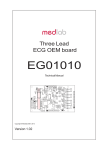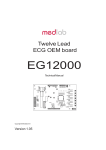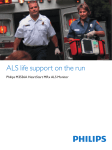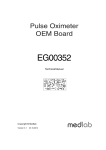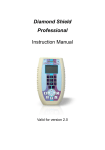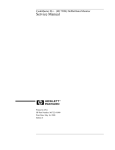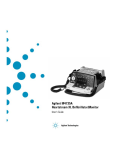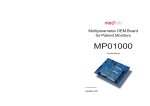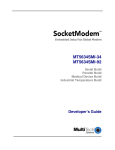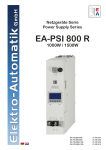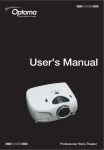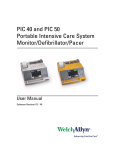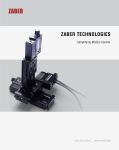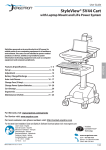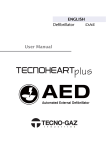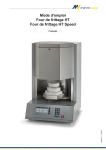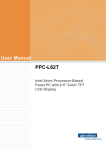Download EG05000 - Medlab GmbH
Transcript
Medlab GmbH EG05000 User Manual medlab Five Lead ECG OEM board EG05000 Technical Manual Copyright © Medlab 2013 Version 1.09 1 Version 1.09 Medlab GmbH EG05000 User Manual Medlab GmbH [email protected] www.medlab.eu Version 1.09 2 Medlab GmbH EG05000 User Manual Table of Content Mechanical Dimensions 4 Overview 4 Module Connectors 5 Physical Units of Data 5 Specifications 6 Connector Assignment 7 Compliance with IEC60601-2-27 8 Serial Transmission 10 Software Protocol Description Introduction 11 Packet Description 13 Commands 16 PC Test Program 17 Regulatory Considerations 18 Revisions of this document 19 3 Version 1.09 Medlab GmbH EG05000 User Manual Mechanical Dimensions $OO 'LPHQVLRQV LQ PP mechanical drawing, top view of the module (1:1) Overview The EG05000 is a five lead ECG module. The module can work with a five lead cable to show 7 channels, with a four lead cable showing 6 channels and with a three lead cable to show one channel of ECG. An advanced pulse detection algorithm is integrated. The board includes a full type CF patient isolation and is powered by a single 5 VDC supply, consuming less than 250 mW. All input leads are fully defibrillation protected. It is possible to measure the respiration rate of the patient using the impedance change between the electrodes. For this, the optional respiration board has to be attached to the module. When using a five lead cable, the module can output the following channels synchronously: I, II, III, aVR, aVL, aVF, C. When using a four lead cable, the module can output the following channels synchronously: I, II, III, aVR, aVL, aVF. When using a three lead cable, the module can output the following channels: I or II or III. Version 1.09 4 Medlab GmbH EG05000 User Manual Module Connectors &RQQHFWRU 5HVSLUDWLRQ %RDUG 0RXQWLQJ +ROHV 3DWLHQW &DEOH &RQQHFWRU +RVW 3RZHU &RQQHFWRU 3DWLHQW ,VRODWLRQ &RQQHFWRU 5HVSLUDWLRQ %RDUG Description of connectors and areas of the module (1:1) Physical Units of Data Scaling of ECGs is done in the units "cm/mV" for the Y-axis and in "mm/sec" for the Xaxis. Respiration rate is transmitted in „rpm“ (respirations per minute). Pulse rate is transmitted in „bpm“ (beats per minute). Transmission speed for the wave is indicated in Hz (sec-1). ECG amplitudes are typically indicated in „cm/mV“. Since this is directly depending on the resolution of the screen the user is working on, the transmitted samples are not scaled, but fall into the range of 0-0xF7 (8 Bit samples, 0xF8 to 0xFF reserved for commands). It is within the responsibility of the user to scale the transmitted samples in a way that the waves displayed on his screen fit to the usual scales used in medicine, 0.5, 1, 2, and 4 cm/mV. The amplification of the module in the different amplification stages is: Stage 1 1mV = 32 Stage 2 1mV = 64 Stage 3 1mV = 128 Stage 4 1mV = 256 Standard values for the trace speed are 12.5 mm/sec, 25 mm/sec and 50 mm/sec. 5 Version 1.09 Medlab GmbH EG05000 User Manual Technical Data Mechanical size: 88 mm x 53 mm see page 4 for board drawing 4 layer PCB, thickness 1.6 mm Maximum height: With respiration option: 12 mm 25 mm Attachment: four M2.5 screws in the corners of the PCB Weight: 32 g Operating voltage: 5 Volt, +- 10%, 50 mA Power consumption: 250 mW while measuring Input: Isolation: Leakage: Defibrillation protected 4000 Volts RMS Better than class CF requirements (<10 µA) Amplification: Data transmission: Filtering: Four stages, user selectable Four data output rates, user selectable 50 Hz, 60 Hz or no notch filter Amplifier frequency range: Operating modes: Lower edge frequency: Upper edge frequency: 0.05 to 70 Hz Monitoring - and diagnostic mode, selectable by command 0.67 Hz (monitoring) or 0.05 Hz (diagnostic) 40 Hz (monitoring) or 70 Hz (diagnostic) QRS detection: Respiration detection: 30 .. 247 bpm +- 1%, +- 1 Digit, 12 beat average 5 .. 99 rpm +-3%, +- 1 Digit, 8 samples average (option) Pacemaker detector +/-2mV to +/-700mV, 0.5-2ms pulse width, (can also be turned off) Pacemaker: Output: Asynchronous serial output with CMOS levels (0...5 V) Separate pulse trigger output, CMOS levels (0...5 V) Both outputs fully isolated from patient Protocol: Bidirectional, packet oriented, serial protocol Connector: Mechanically compatible to Medlab EG01010 three channel OEM board and the EG12000 twelve channel ECG board. Version 1.09 6 Medlab GmbH EG05000 User Manual Connectors Header for host connection: JP1: 1 2 3 4 5 6 7 8 9 10 11 12 13 14 15 16 Ground Ground Txd (RS232 level +/- 5Volt) Txd (TTL level) Rxd (RS232 level +/- 5Volt) Rxd (TTL level) Not connected Not connected Not connected Not connected Pulse Trigger output Pulse Trigger output Shutdown Shutdown (VCC level on these pins powers down module) VCC input VCC input Header for patient cable connection: SV1: 1 2 3 4 5 6 7 C-IN SHIELD LL-IN RA-IN LA-IN SHIELD RL-IN Chest Isolated Ground Left Leg Right Arm Left Arm Connected to pin 2 Right leg 7KUHH /HDG 3DWLHQW &DEOH )LYH /HDG 3DWLHQW &DEOH )RXU /HDG 3DWLHQW &DEOH 6KLHOG 6KLHOG 5LJKW /HJ /HIW $UP /HIW $UP /HIW /HJ /HIW /HJ 5LJKW $UP 6KLHOG /HIW $UP 5LJKW $UP 5LJKW $UP 6KLHOG 6KLHOG 6KLHOG , RU ,, RU ,,, /HIW /HJ &KHVW , DQG ,, DQG ,,, DQG D9/ DQG D95 DQG D9) , DQG ,, DQG ,,, DQG D9/ DQG D95 DQG D9) DQG & ECG cable connection 7 5LJKW /HJ Version 1.09 Medlab GmbH EG05000 User Manual Technical description for TRF IEC 60601-2-27: When preparing a test report form (TRF) for proof of compliance of the users medical product to IEC60601-2-27:2005, the following remarks / technical data will be helpful or needed: Input Impedance: Common mode rejection ratio: Input Dynamic Range: Defibrillator Discharge Recovery: Leads-off sensing current: > 10 MOhm > 90 dB at 50 Hz or 60 Hz ±5 mV AC, ±300 mV DC <10 sec per IEC 601-2-27 <10 sec per AAMI EC13-1992 Applied currents less than 150 nA The following information references particular sections of IEC and EN 60601-2-27: Respiration (optional) Section 6.8.2.bb.1) Applied currents less than 80 µA @ 90kHz square Tall T-wave rejection. Section 6.8.2.bb.2) T-wave of 1.2 mV amplitude will not affect heart rate determination. Heart rate averaging. Section 6.8.2.bb.3) The pulse rate is averaged over the last 12 detected pulses. QRS Detection (various sections) If the EG05000 is set to adult mode, the heart rate meter will not respond to ECG signals having a QRS amplitude of 0,15mV or less, or R-waves of a duration of 10 ms or less, with an amplitude of 1 mV. The detection range of QRS amplitudes is 0,5 mV to 5 mV, for durations of the QRS complex ranging from 50 ms to 120 ms, up to a signal rate of 300 BPM. If the EG05000 is set to neonate mode, the detection range of QRS amplitudes is 0,5 mV to 5 mV, for durations of the QRS wave ranging from 40 ms to 120 ms, up to a signal rate of 350 BPM. Response to irregular rhythm. Section 6.8.2.bb.4) A1) Ventricular bigeminy: the EG05000 counts both large and small QRS complexes to display a rate of 80 bpm. A2) Slow alternating ventricular bigeminy: the EG05000 counts both large and small QRS complexes to display a rate of 60 bpm. A3) Rapid alternating ventricular bigeminy: the EG05000 counts all QRS complexes to display a rate of 120 bpm. A4) Bi-directional systoles: the EG05000 counts all QRS complexes to display a rate of 90 bpm. Heart rate meter response time. Section 6.8.2.bb.5) a) Change from 80 to 120 BPM: 4 sec b) Change from 80 to 40 BPM: 7 sec Time to alarm for tachycardia. Section 6.8.2.bb.6) Waveform B1: Amplitude 0,5 mV 1 mV 2 mV Waveform B2 Amplitude 1 mV 2 mV 4 mV Version 1.09 Time to alarm 1 sec 1 sec 1 sec time to alarm 1 sec 1 sec 1 sec 8 Medlab GmbH EG05000 User Manual Pacemaker pulse display capability (See IEC 601-2-27 clause 50.102.12) The EG05000 is capable of displaying the ECG signal in the presence of pacemaker pulses with amplitudes of ±2 mV to ±700 mV and durations of 0.5 ms to 2.0 ms. An indication for the pacemaker pulse is provided. Pacemaker pulse rejection (See IEC 601-2-27 clause 50.102.13) Without over and undershoot (rectangular pulse): a) For single (ventricular-only) pacemaker pulses alone, with 0.1 and 2.0 ms pulse-widths and ±2 mV and ± 700 mV pulse-amplitudes, the EG05000 correctly displays heart rate as zero bpm (Asystole). b) For single (ventricular-only) pacemaker pulses with normally paced QRS-T, with 0.1 and 2.0 ms pulse-widths and ±2 mV and ± 700 mV pulse-amplitudes, the EG05000 correctly displays heart rate of the QRS-T rhythm (60 bpm for the specified test waveform). c) For single (ventricular-only) pacemaker pulses with ineffectively paced QRS pattern, with 0.1 and 2.0 ms pulse-widths and ±2 mV and ± 700 mV pulse-amplitudes, the EG05000 correctly displays heart rate of the underlying QRS-T rhythm (30 bpm for the specified waveform). d) For atrial/ventricular pacemaker pulses alone, with 0.1 and 2.0 ms pulse-widths and ±2 mV and ± 700 mV pulse-amplitudes, the EG05000 correctly displays heart rate of zero bpm (Asystole). e) For atrial/ventricular pacemaker pulses with normally paced QRS-T, with 0.1 and 2.0 ms pulsewidths and ±2 mV and ± 700 mV pulse-amplitudes, the EG05000 correctly displays heart rate of the QRS-T rhythm (60 bpm for the specified test waveform). f) For atrial/ventricular pacemaker pulses with ineffectively paced QRS pattern, with 0.1 and 2.0 ms pulse-widths and ±2 mV and ± 700 mV pulse-amplitudes, the EG05000 correctly displays heart rate of the underlying QRS-T rhythm (30 bpm for the specified test waveform). With over and undershoot: a) For single (ventricular-only) pacemaker pulses alone, with 0.1 and 2.0 ms pulse-widths and ±2 mV and ± 700 mV pulse-amplitudes, the EG05000 correctly displays heart rate of zero bpm (Asystole). b) For single (ventricular-only) pacemaker pulses with normally paced QRS-T, with 0.1 and 2.0 ms pulse-widths and ±2 mV and ± 700 mV pulse-amplitudes, the EG05000 correctly displays heart rate of the QRS-T rhythm (60 bpm for the specified waveform). c) For single (ventricular-only) pacemaker pulses with ineffectively paced QRS pattern, with 0.1 and 2.0 ms pulse-widths and ±2 mV and ± 700 mV pulse-amplitudes, the EG05000 correctly displays heart rate of the underlying QRS-T rhythm (30 bpm for the specified waveform). d) For atrial/ventricular pacemaker pulses alone, with 0.1 and 2.0 ms pulse-widths and ±2 mV and ± 700 mV pulse-amplitudes, the EG05000 correctly displays heart rate of zero bpm (Asystole). e) For atrial/ventricular pacemaker pulses with normally paced QRS-T, with 0.1 and 2.0 ms pulsewidths and ±2 mV and ± 700 mV pulse-amplitudes, the EG05000 correctly displays heart rate of the QRS-T rhythm (60 bpm for the specified test waveform). f) For atrial/ventricular pacemaker pulses with ineffectively paced QRS pattern, with 0.1 and 2.0 ms pulse-widths and ±2 mV and ± 700 mV pulse-amplitudes, the EG05000 correctly displays heart rate of the underlying QRS-T rhythm (30 bpm for the specified test waveform). 9 Version 1.09 Medlab GmbH EG05000 User Manual Serial Transmission The host connection to the board is a serial, asynchronous communication interface operating at 115200 baud, 8 data bits, an even parity bit and one stop bit. Both CMOS and RS232 (+/- 5 Volt level) voltage levels are available. The protocol is block oriented. Each block also includes a checksum in the transmitted data. The RS232 voltage levels are helpful during evaluation of the board, which can be done using an ordinary PC and a special software. The connection in the customer's final system will typically be done through 0V/5V levels, which saves electronic components on the host side of the data stream. Connector JP1 is compatible with the interface connector on Medlab's EG01010 three channel ECG OEM board. Therefore, test cables that had been built for this board can also be used for the EG05000 board. The EG05000 sends data and receives commands. Commands are one byte characters, some of them have an additional parameter, others just toggle an internal switch in the EG05000 module. The neutral line of the ECG is located at 128 (0x80), since the module transmits unsigned data. For details, please see the protocol description on the following pages. Version 1.09 10 Medlab GmbH EG05000 User Manual Serial Transmission Protocol The board transmits up to 8 graphical waveforms synchronously, a pulse value, a respiration value (if the optional respiration board is fitted to the base ECG board) and several status bytes. Transmission is done in blocks. The integrity of the blocks is secured by: 1) an even parity bit in each transmitted byte. 2) a checksum for each block Even parity in this case means that the sum of all bits in one byte, including the parity bit, is „0“. The module can receive commands over its serial interface. For example, the user can select transmission speed of the wave block, set the amplification of the ECG amplifiers and select which channels should be transmitted by the board. The transmitted channels that are available with a five lead cable are: 1) I, Einthoven Lead 2) II, Einthoven Lead 3) III, Einthoven Lead 4) aVR, Goldberger Lead 5) aVL, Goldberger Lead 6) aVF, Goldberger Lead 7) C1, one Wilson lead that should be placed on the chest of the patient 8) Respiration curve To reduce overhead for the waveform transmission, the wave block uses another checksum algorithm as the status and value blocks do. The EG05000 works with a three lead-, a four lead- or a five lead cable. Only parts of the maximum number of channels can be measured if not all five electrodes are connected (see page 7). The board contains a lead-off detection that gives information about each single nonconnected electrode. It is not possible for the module to automatically detect which cable is connected, since the situation is the same whether, for example, a three lead cable or a five lead cable with two non-attached leads is used. It is recommended for the user to use a connection system with coded cables (shorted, unused pins in the connector for example), to make the host system aware of which cable style currently is connected to the EG05000 and to ignore lead-off messages that do not exist for the respective cabling system. The simplest solution is to have the enduser select which cable is connected in a menu entry in the host's user interface. Channels that are requested by the host but cannot be measured, because of no electrode contact or the respective lead missing in the cable, are transmitted as "0x80", neutral line. Transmission is done in blocks. The basic interface parameters are: 115200 baud, 1 start bit, 8 data bits, an even parity bit and one stop bit. The first block transmitted will be a status block. 11 Version 1.09 Medlab GmbH EG05000 User Manual The default settings after power up are: 100 wave blocks per second, I,II,III activated, 1cm/mV amplification, monitoring bandwidth, 50 Hz filter active. The host can adjust this to his needs by sending commands to the module. To keep the traffic on the serial line as low as possible, the following protocol has been implemented. The reasons for choosing this protocol where as following: The wave blocks are to be transmitted quite often (up to 300 times per second) and sometimes they contain only one channel of information. For this single channel, one needs at least: a block header, a counter, a checksum and the wave sample value itself. To reduce overhead, the number of wave samples in package have been packed into one byte, together with the checksum. The checksum for the wave packet is therefore only 4 bits long, because the remaining four bits are needed for the wave counter. The status and the value blocks use 7 bit checksums. There is still enough security, because each byte has its own parity bit. Transmitted blocks: 1. There are three types of regular data packets, waveform blocks, value blocks and status blocks. Beginning of a packet is indicated by the marker 0xF8 (wave), 0xF9 and 0xFA (values) and 0xFC (status). Every other transmitted byte has a value of less than 0xF8. This allows for easy synchronisation. 2. Waveform blocks are transmitted 50, 100, 150 or 300 times per second, as defined by the last „Speed“ command. Initial value is 100 / sec. 3. Status blocks are transmitted once per second. 4. Value blocks are transmitted at each detected pulse (0xFA marker, can be used for a pulse „beep“) and at each detected respiration (0xF9 marker). 5. The data protocol is self synchronizing, e.g. one cannot loose synchronisation when some bytes are lost during transmission. Only one package is lost in that case. 6. There is one special package: after receiving the command „I“ („identify“), the board sends a string that contains the board’s name, hardware version info („H0“), and software version info („S01“). This string is in ASCII format, and is zero terminated. The identification block starts with marker 0xFD, to ease decoding. Example for answer to identify command: <0xFD>"EG05000H0S01"<0x00> On the next page, the structure of the blocks are described. Version 1.09 12 Medlab GmbH EG05000 User Manual A waveform block contains between three and 10 bytes: Bit 7 Bit 6 Bit 5 Bit 4 Bit 3 Bit 2 Bit 1 Bit 0 Byte 1 Sync 1 1 1 1 1 0 0 0 Byte 2 Ctr/Chk Bit 3 Ctr Bit 2 Ctr Bit 1 Ctr Bit 0 Ctr Bit3 Chksum Bit2 Chksum Bit1 Chksum Bit0 Chksum Byte 3 Wave 1 Bit 7 Wave 1 Bit 6 Wave 1 Bit 5 Wave 1 Bit 4 Wave 1 Bit3 Wave 1 Bit2 Wave 1 Bit1 Wave 1 Bit0 Wave 1 Byte 4 Wav e 2 Bit 7 Wave 2 Bit 6 Wave 2 Bit 5 Wave 2 Bit 4 Wave 2 Bit3 Wave 2 Bit2 Wave 2 Bit1 Wave 2 Bit0 Wave 2 Byte 5 Wav e 3 Bit 7 Wave 3 Bit 6 Wave 3 Bit 5 Wave 3 Bit 4 Wave 3 Bit3 Wave 3 Bit2 Wave 3 Bit1 Wave 3 Bit0 Wave 3 Byte 6 Wav e 4 Bit 7 Wave 4 Bit 6 Wave 4 Bit 5 Wave 4 Bit 4 Wave 4 Bit3 Wave 4 Bit2 Wave 4 Bit1 Wave 4 Bit0 Wave 4 .. . . .. . . 2+Ctr bytes are transmitted in this block. Ctr is the number of wave samples in the block. The checksum is the sum of all bytes in the block, with byte 2, the chksum itself, ignored for the sum. It includes the sync character (byte 1). Since only 4 bits can be used, the result is "anded" with 0x0F. The wave samples are limited to a number of 0xF7, so no mix-up with sync bytes can occur. The channels are not mapped to a byte position in the block, since the user can freely enable/disable the channels independently of each other. The transmission sequence is always: I, II, III, aVR, aVL, aVF, C1, Respiration Example 1: the host requests „I“,“aVF“ and „C1“ to be transmitted. Wave 1 will be „I“, Wave 2 will be „aVF“, and Wave 3 will be „C1“ , the block being 5 bytes long. Example 2: the host requests „C1“ and respiration waveform to be transmitted. Wave 1 will be „C1“, Wave 2 will be respiration waveform, the block being 4 bytes long. A value block contains three bytes: Bit 7 Bit 6 Bit 5 Bit 4 Bit 3 Bit 2 Bit 1 Bit 0 Byte 1 Sync 1 1 1 1 1 0 Bit 1 Type Bit 0 Type Byte 2 Chksum 0 Bit 6 Chksum Bit 5 Chksum Bit 4 Chksum Bit 3 Chksum Bit 2 Chksum Bit 1 Chksum Bit 0 Chksum Byte 3 Value Bit 7 Value Bit 6 Value Bit 5 Value Bit 4 Value Bit 3 Value Bit 2 Value Bit 1 Value Bit 0 Value 13 Version 1.09 Medlab GmbH EG05000 User Manual 3 bytes are transmitted in this block. Type == 00 -> not used Type == 10 -> respiration value Type == 01 -> pulse value Type == 11 -> not used, but reserved for future extensions The checksum is the sum of all bytes in the block, with byte 2, the chksum itself, ignored for the sum. It includes the sync character (byte 1). Since only 7 bits are used, the result is "anded" with 0x7F. The values are limited to a number of 0xF7, so no mix-up with sync bytes can occur. A Status block contains six bytes: Bit 7 Bit 6 Bit 5 Bit 4 Bit 3 Bit 2 Bit 1 Bit 0 Byte 1 Sync 1 1 1 1 1 1 0 0 Byte 2 Chksum 0 Bit 6 Chksum Bit5 Chksum Bit 4 Chksum Bit3 Chksum Bit2 Chksum Bit1 Chksum Bit0 Chksum Byte 3 Electrode 0 Respwav X Chest RA LA RL LL Byte 4 Channels 0 C1 aVF aVL aVR III II I Byte 5 EKGStat X Bit 1 Filter 2 Bit 0 Filter 2 EMG Filter1 Bit 1 Amp Bit 0 Amp Bit 1 Speed Bit 0 Speed Byte 6 Status 0 N X X Bit 3 S3 Bit 2 S2 Bit 1 S1 Bit 0 S0 5 bytes are transmitted in this block. „X“ means the bit is unused and undefined The checksum is the sum of all bytes in the block, with byte 2, the chksum itself, ignored for the sum. It includes the sync character (byte 1). Since only 7 bits are used, the result is "anded" with 0x7F. Electrodes, Byte 3: a „1“ in the respective bit position 0 .. 4 means this electrode is connected Respwav: „1“ respiratory waveform sample is transmitted „0“ respiratory waveform sample is not transmitted Channels, Byte 4: a „1“ in the respective bit position 0 .. 6 means this wave is transmitted EKG Status, Byte 5: Speed: Amp: Version 1.09 „00“ 50 wave blocks per second „01“ 100 wave blocks per second „10“ 150 wave blocks per second „11“ 300 wave blocks per second „00“ Amplification stage 1 (lowest) „01“ Amplification stage 2 „10“ Amplification stage 3 „11“ Amplification stage 4 (highest) 14 Medlab GmbH EG05000 User Manual Filter1: Filter2: Status, Byte 6: „0“ EMG filter off „1“ EMG filter on „00“ 50/60 Hz filter off „01“ 50 Hz filter on „10“ 60 Hz filter on N 0 1 S0..3 0000 Normal operation S0..3 0001 Normal operation, pacemaker detected S0..3 0100 Initializing S0..3 0101 Searching for electrodes S0..3 1000 Simulated output S0..3 1010 Selftest error Rest: Adult mode Neonatal mode Not used, but reserved „Selftest error“ (10) errors are fatal. The module will never go into measuring state. Status message 8 will be transmitted as long as simulated data is transmitted. 15 Version 1.09 Medlab GmbH EG05000 User Manual Commands from Host to Module All commands have a one or two byte structure. They are also sent to the module with 115200 baud. The commands are sent in ASCII format. Basic Bandwidth of ECG amplifier (Diagnostic or Monitoring mode): „F“ Parameter: "0" or "1" „0“ bandwidth of the amplifier DC-80 Hz Diagnostic mode (bear in mind mains filter setting) „1“ bandwidth of the amplifier 0.67-40 Hz Monitoring mode (reset value) Transmission frequency of the waveform packet: „S“ Parameter: "0", "1", "2" or "7" (0x53 0x31 for example for „S1“) „0“ send waveform packets 50 times per second „1“ send waveform packets 100 times per second „2“ send waveform packets 150 times per second „7“ send waveform packets 300 times per second (reset value) Amplification of the waveforms „A“ Parameter: "0“, "1“, "2" or "3" (0x41 0x31 for example for „A1“) „0“ Amplification stage 1 (lowest amplification, should be scaled to 0.5 cm/mV) „1“ Amplification stage 2 „2“ Amplification stage 3 „3“ Amplification stage 4 (highest amplification, should be scaled to 4 cm/mV) Each amplification stage has double the sensitivity of the previous stage Channel selection (1-8 wave channels can be selected) „C“ Parameter: 1 byte. Each bit in the parameter byte set to „1“ stands for a transmitted wave, a „0“ means that wave is not transmitted. 10000000 respiration 01000000 C1 00100000 aVF 00010000 aVL 00001000 aVR 00000100 III 00000010 II 00000001 I Example: to receive I, aVR and respiration, send: 0x43 (character ‚C‘), 0x89 Filtering of the waveforms for 50 and 60 Hz line frequency: „5“ Parameter: "0", "1" or "2" (0x35 0x30 for example for „50“) „0“ 50Hz and 60Hz Filter off „1“ 50Hz Filter on „2“ 60 Hz Filter on Version 1.09 16 Medlab GmbH EG05000 User Manual Filtering of the waveforms for EMG interference (~15-30Hz): „E“ Parameter: „0“ or „1“ (0x45 0x30 for example for „E0“) „0“ EMG Filter off „1“ EMG Filter on (reset value) Set board to adult mode or neonate/pediatric mode: 1) "N" Parameter: "0" or "1" (0x4E 0x30 for example for "N0") "0" board is in adult mode (reset value) "1" board is in pediatric/neonate mode Calibraton mode (1mV rectangle transmitted for 250 samples): „K“ output 250 samples of 1mV rectangular waves, then go back to normal mode Update electrode configuration. Recognizes newly connected electrodes „q0“ Newly connected electrodes are recognized after this command has been sent to the module. Also any other command except "K" and "I" starts a new search for connected electrodes. Simulated data outputs (useful for testing or exhibitions): „M“ Parameter: „0“, or „1“ „0“ use real input for data transmission „1“ use simulated output waves and values (reset value) Pacemaker detection on or off: „P“ Parameter: „0“, or „1“ „0“ do not detect pacemaker pulses „1“ detect pacemaker pulses (reset value) Set delay of the pulse trigger signal (active high, 33ms duration): „T“ Parameter: „0“ , „1“ , „2“ , or „9“ „0“ Delay of the pulse trigger signal 15ms „1“ Delay of the pulse trigger signal 50ms „2“ Delay of the pulse trigger signal 100ms „9“ The signal triggers in the middle between R waves (reset value) Identification of the module: „I“ Identify. A zero terminated ASCII string is transmitted showing module information. The identification block start with marker 0xFD. 1) the third edition of 60601-2-27 requires different detection ranges for adults and neonates. See page 8 "QRS detection", for details. The EG05000 complies with all requirements of the new (and the old) standard. The board powers up in adult mode, the firmware is therefore compatible to the older versions that did not have a neonatal mode. 17 Version 1.09 Medlab GmbH EG05000 User Manual Test Program A Microsoft Windows program (Monitor.exe) is available upon request. The program does not need any installation, just copy it to a directory of your choice and run it. The software allows selection of transmitted channels, sample rate and amplification as well as selecting filters. It graphically displays the selected channels. Regulatory Considerations The device that has been described in this document is not a final medical product. This means that it cannot be used as a standalone unit to use it on patients. Therefore, the EG05000 has not been - and also cannot be - CE-marked. The customer has to undertake the procedure of CE-marking with the final product that contains the module. However, several products on the market have successfully passed this certification. The module complies with the following standards, as far as applicable: EN60601-1:2006 EN60601-1-2:2007 EN60601-1-4:1997 EN60601-2-27:2006 IEC60601-2-27:2011 ANSI/AAMI EC13:2002 ANSI/AAMI EC57:1998 During testing and certification of a product, also the user manual of the final product needs to be certified. The user manual has to contain certain technical data and warnings to the end users. We can support customers by supplying material for the manual that has been used during the certification process of Medlab's devices. Version 1.09 18 Medlab GmbH EG05000 User Manual History: Rev. 0.9: Rev. 0.91: Rev. 0.92: Rev. 1.00: Rev. 1.01: Rev. 1.02: Rev. 1.03: Rev. 1.04: Rev. 1.05: Rev. 1.06: Rev. 1.07: Rev. 1.08: Rev. 1.09: 19 Initial Revision Adjusted Layout, Corrected typographical errors Moved "physical units" to begin of document Changed table of contents Corrected Connector JP1 Layout Added two status messages Corrected packet markers 0xFa 0xF9 Added description of cable selection / electrode detection (page 11) Added technical data required for testing against IEC60601-2-27 Added brief description of the test program Removed reference to EG01010 and protocol switching on power up Exchanged the word "packet" with "block" Corrected grammatical errors Added outputs to technical data page Corrected JP1 description. Added Marker description for "Identify" block Corrected description of EKGStat byte in status block Added JP1 "pulse trigger" and "shutdown pin" clarification Packet markers 0xFA and 0xF9 are exchanged again Changed company address Added command description: Fx, Px, Tx Corrected typographical errors Changed manufacturer address Changed pulse range and averaging to 12 beats Added neonatal mode because of 10ms R-wave suppression requirements Added explanation for checksum generation, corrected mentioned size of status block Version 1.09 Medlab GmbH EG05000 User Manual Medlab medizinische Diagnosegeräte GmbH Helmholtzstrasse 1 76297 Stutensee (Karlsruhe) Germany Tel. +49(0)7244 741100 [email protected] www.medlab-gmbh.de Version 1.09 20





















